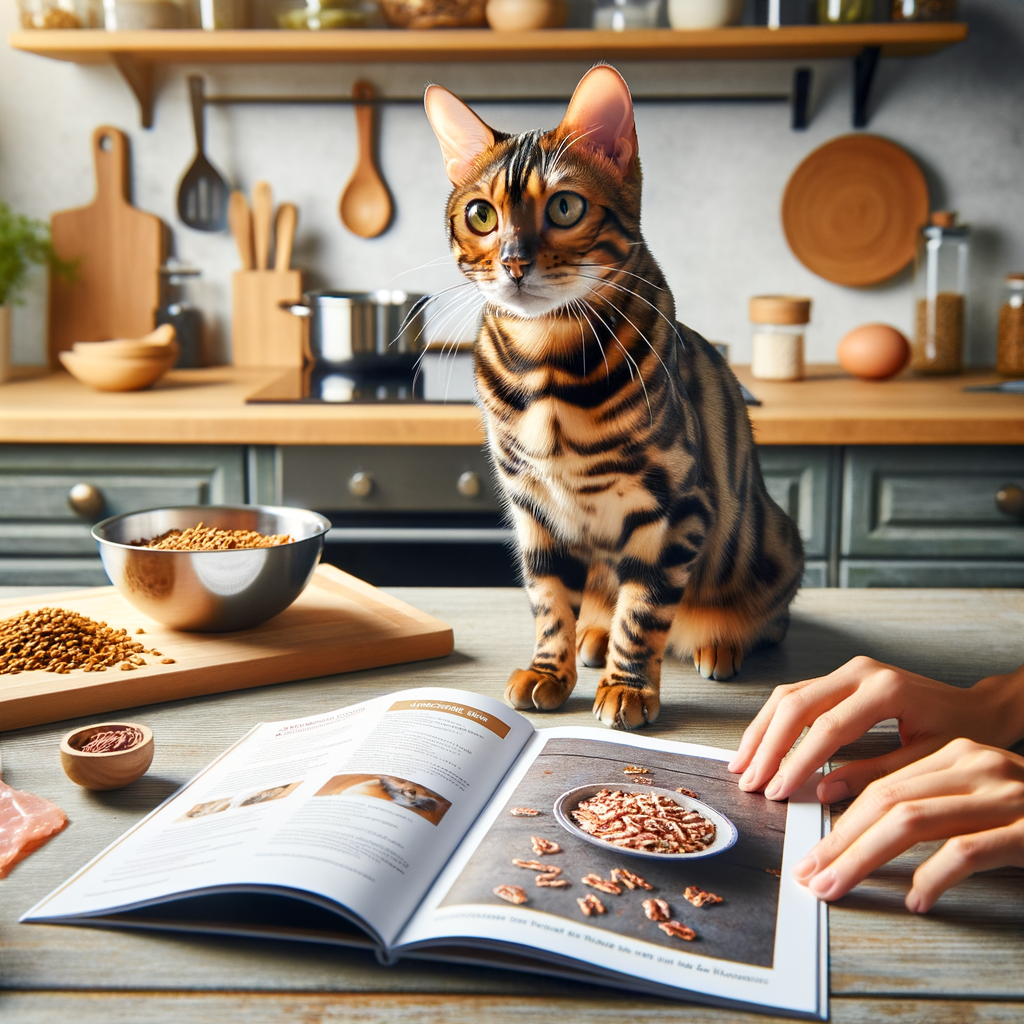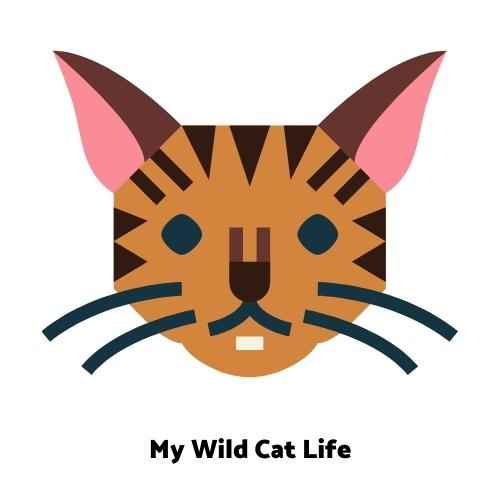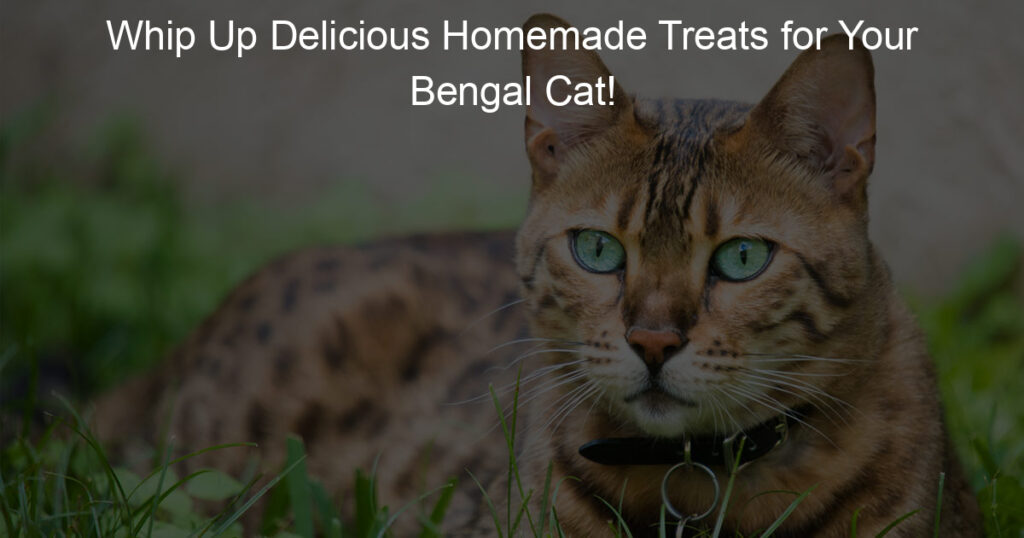
Introduction to Bengal Cat Diet
When it comes to the health and happiness of your Bengal cat, diet plays a crucial role. Understanding the unique dietary needs of Bengal cats and providing a balanced diet is essential. In this section, we will delve into these topics to ensure your Bengal cat leads a healthy and active life.
Bengal cats, known for their striking coat and playful nature, have unique dietary needs that set them apart from other breeds. They are active and muscular cats, which means they require a diet rich in protein to support their energy levels and muscle health. Unlike other breeds, Bengal cats may not thrive on a diet solely based on commercial cat food. They often need a mix of high-quality commercial food and fresh, raw or cooked meats.
A balanced diet is vital for your Bengal cat’s overall health. It ensures they get the right amounts of vitamins, minerals, and nutrients they need to stay healthy. A balanced diet for a Bengal cat should include high-quality protein sources, a moderate amount of fats, and a minimal amount of carbohydrates. It’s also important to ensure they have access to fresh water at all times.
Feeding your Bengal cat a balanced diet can help prevent health issues such as obesity, diabetes, and heart disease. It can also contribute to a shiny coat, healthy skin, and bright eyes. Remember, every cat is unique, so it’s important to monitor your cat’s weight and adjust their diet as needed.
| Dietary Component | Percentage in Diet |
|---|---|
| Protein | 40-45% |
| Fats | 20-25% |
| Carbohydrates | 5-10% |
Understanding your Bengal cat’s dietary needs and providing a balanced diet is the first step towards ensuring their health and happiness. In the following sections, we will explore homemade cat treats, Bengal cat food recipes, and more to help you provide the best diet for your Bengal cat.
Benefits of Homemade Cat Treats
Homemade cat treats offer a range of benefits that can significantly improve the health and happiness of your beloved feline friend. Here are some of the key advantages:
- Control over ingredients for healthier options
When you make your own cat treats, you have complete control over what goes into them. This means you can choose high-quality, nutritious ingredients and avoid anything that might be harmful or unhealthy for your cat. For example, many store-bought treats contain artificial colors, flavors, and preservatives that some cats might be sensitive to. By making your own treats, you can ensure that your cat is getting only the best.
- Ability to cater to your cat’s specific dietary needs
Every cat is unique, and what works for one might not work for another. Some cats have specific dietary needs due to allergies, sensitivities, or health conditions. Homemade treats allow you to tailor the recipe to your cat’s individual needs. Whether your cat needs a low-fat diet, has a grain allergy, or requires extra protein, you can adjust the ingredients accordingly when you make your own treats.
- Cost-effective in the long run
While buying ingredients for homemade treats might seem expensive upfront, it can actually save you money in the long run. Store-bought treats can be pricey, especially if you’re buying high-quality or specialty products. By making your own, you can create a large batch of treats at a fraction of the cost. Plus, healthier treats can lead to fewer vet bills down the line.
In conclusion, homemade cat treats are a wonderful way to show your cat some love while also taking an active role in their health and nutrition. Not only can you cater to their specific dietary needs, but you can also ensure that they’re eating only the best ingredients. And, as an added bonus, making your own treats can be a fun and rewarding experience!
Getting Started with DIY Cat Treats
Creating your own cat treats at home is a fun and rewarding process. Not only does it allow you to control the ingredients that go into your cat’s diet, but it also gives you a chance to cater to your cat’s unique taste preferences. Let’s explore how to get started with making DIY cat treats.
- Choosing the Right Ingredients
When it comes to making cat treats, the ingredients you choose are crucial. Cats are carnivores, so their diet should primarily consist of meat. However, some fruits, vegetables, and grains can also be included for added nutrition. Always avoid ingredients that are toxic to cats, such as onions, garlic, chocolate, and certain artificial sweeteners.
| Good Ingredients | Bad Ingredients |
|---|---|
| Meat (chicken, fish, turkey) | Onions |
| Fruits (apples, bananas) | Garlic |
| Vegetables (carrots, peas) | Chocolate |
| Grains (rice, oats) | Artificial sweeteners |
- Understanding Your Cat’s Preferences
Every cat is unique and has its own taste preferences. Some cats might prefer fish, while others might prefer chicken. It’s important to pay attention to what your cat likes and dislikes. You can do this by offering them a variety of foods and observing their reactions. Remember, the goal is to make treats that your cat will love!
- Preparing Your Kitchen for Making Cat Treats
Before you start making cat treats, it’s important to prepare your kitchen. This includes cleaning your workspace, gathering all the necessary ingredients and tools, and preheating your oven if necessary. It’s also a good idea to have a recipe in mind before you start. This will help you stay organized and ensure that the process goes smoothly.
With these steps in mind, you’re ready to start making your own DIY cat treats. Remember, the key is to use high-quality ingredients and cater to your cat’s unique taste preferences. Happy cooking!
Bengal Cat Food Recipes
Feeding your Bengal cat with homemade food can be a rewarding experience. Not only does it allow you to control the ingredients, but it also gives you a chance to create meals that your cat will love. Let’s start with a simple, nutritious recipe: Tuna Treats.
Recipe 1: Tuna Treats
This recipe is a favorite among many Bengal cats. It’s packed with protein and omega-3 fatty acids, which are essential for your cat’s health. Here’s how you can make it:
-
- Ingredients needed:
Here’s what you’ll need to make Tuna Treats for your Bengal cat:
-
-
- 1 can of tuna in water (drained)
- 1 egg
- 1 cup of flour
- 1/2 cup of dried catnip
- Step by step preparation:
-
Follow these steps to prepare the Tuna Treats:
-
- Preheat your oven to 350 degrees Fahrenheit.
- In a bowl, mix the tuna, egg, and catnip together.
- Gradually add the flour, stirring until the mixture forms a dough.
- Roll out the dough and cut into small, cat-friendly pieces.
- Place the pieces on a baking sheet and bake for about 20 minutes, or until golden brown.
- Let the treats cool before giving them to your cat.
Remember, these treats should not replace your cat’s regular meals. They are meant to be a special treat and should make up no more than 10% of your cat’s daily caloric intake. Always consult with your vet before making any changes to your cat’s diet.
Recipe 2: Chicken and Pumpkin Bites
Our second recipe is a delightful combination of chicken and pumpkin. This treat is not only tasty but also packed with essential nutrients that your Bengal cat needs. Let’s dive into the ingredients and steps required to prepare this delicious treat.
-
- Ingredients needed
Here are the ingredients you’ll need for this recipe:
| Ingredient | Quantity |
|---|---|
| Chicken (cooked and shredded) | 1 cup |
| Pumpkin puree (unsweetened) | 1/2 cup |
| Pea flour | 2 tablespoons |
| Egg | 1 |
Ensure that the chicken is thoroughly cooked and shredded into small, bite-sized pieces. The pumpkin puree should be unsweetened, as sugar is not healthy for cats. Pea flour is a great source of protein and is easily digestible for cats.
-
- Step by step preparation
Follow these steps to prepare the Chicken and Pumpkin Bites:
-
-
- Preheat your oven to 350°F (175°C).
- In a bowl, mix the shredded chicken, pumpkin puree, pea flour, and egg until well combined.
- Shape the mixture into small, bite-sized balls and place them on a baking sheet lined with parchment paper.
- Bake for 15-20 minutes or until the treats are firm and golden brown.
- Allow the treats to cool completely before serving them to your Bengal cat.
-
Remember, these treats should be served in moderation as part of a balanced diet. Always consult your vet before introducing any new food to your cat’s diet.
Making Cat Treats at Home: Tips and Tricks
Creating homemade cat treats for your Bengal cat can be a fun and rewarding experience. Not only do you get to control the ingredients, but you also get to witness the joy your feline friend experiences when they taste your homemade creations. Here are some tips and tricks to help you make the best cat treats at home.
-
- Storing homemade cat treats
Proper storage is key to maintaining the freshness and quality of your homemade cat treats. After baking and cooling the treats, place them in an airtight container. Store this container in a cool, dry place away from direct sunlight. If you’ve made a large batch, consider freezing some of the treats. They can last up to six months in the freezer. Just remember to thaw them before giving them to your cat.
-
- Introducing new treats to your Bengal cat
Bengal cats, like all felines, can be picky eaters. When introducing a new treat, start with a small amount. Observe your cat’s reaction. If they seem to enjoy it, gradually increase the quantity over time. Also, remember to introduce only one new treat at a time. This way, if your cat has an adverse reaction, you’ll know which treat caused it.
-
- Keeping treats exciting and varied
Just like humans, cats can get bored with the same food. To keep things exciting, try varying the types of treats you make. Experiment with different flavors and textures. For example, you could make crunchy treats one week and soft, chewy treats the next. You could also try using different ingredients, like fish, chicken, or vegetables. Remember, variety is the spice of life, even for cats!
In conclusion, making cat treats at home can be a fun and rewarding experience. With these tips and tricks, you can ensure that your Bengal cat enjoys a variety of tasty and nutritious treats. Happy baking!
Understanding Bengal Cat Nutrition
When it comes to Bengal cats, nutrition plays a vital role in their overall health and well-being. Understanding their nutritional needs and common dietary issues can help you provide the best care for your feline friend. Let’s delve deeper into these topics.
- Nutritional needs of a Bengal cat
Bengal cats are known for their active and playful nature. To fuel their energy, they require a balanced diet rich in proteins, fats, and carbohydrates. Here’s a breakdown of their nutritional needs:
| Nutrient | Percentage |
|---|---|
| Proteins | 40% |
| Fats | 30% |
| Carbohydrates | 30% |
Proteins are essential for muscle development and repair, while fats provide a concentrated source of energy. Carbohydrates, though not a primary requirement, can provide additional energy and aid digestion when included in moderate amounts.
- Common dietary issues and how to avoid them
Despite their robust nature, Bengal cats can face certain dietary issues. These include obesity, food allergies, and digestive problems. Here are some tips to avoid these issues:
- Obesity: Overfeeding or feeding your Bengal cat a diet high in fats and carbohydrates can lead to obesity. To prevent this, ensure portion control and provide a balanced diet.
- Food Allergies: Some Bengal cats may be allergic to certain foods like dairy or grains. If you notice any allergic reactions, consult a vet and modify their diet accordingly.
- Digestive Problems: Sudden changes in diet can cause digestive issues. Always introduce new foods gradually and monitor your cat’s reaction.
Understanding your Bengal cat’s nutritional needs and being aware of common dietary issues can go a long way in ensuring their health and happiness. Remember, every cat is unique, and what works for one may not work for another. Always consult with a vet for personalized advice.
Homemade Pet Food: Beyond Treats
When it comes to feeding your Bengal cat, homemade meals can offer a variety of benefits. Not only can you control the quality of the ingredients, but you can also tailor the meals to your cat’s specific dietary needs. Let’s delve into how to create balanced meals for your Bengal cat.
Creating Balanced Meals for Your Bengal Cat
Creating a balanced meal for your Bengal cat involves careful consideration of ingredients and portion sizes. Let’s take a closer look at these two crucial aspects.
-
- Ingredients to Include for a Balanced Meal
Protein should be the main component of your Bengal cat’s diet. This can come from sources such as chicken, turkey, or fish. Additionally, include a small amount of carbohydrates from sources like sweet potatoes or peas. Lastly, don’t forget to add some fruits and vegetables for fiber and essential vitamins and minerals.
-
- Portion Sizes and Feeding Schedules
Portion sizes depend on your cat’s age, weight, and activity level. Generally, an adult Bengal cat should eat approximately 4-5 ounces of food per day, divided into two meals. Kittens require more frequent feeding, usually three to four times a day. Always consult with your vet to determine the best feeding schedule and portion sizes for your specific cat.
Remember, while homemade meals can be a healthy choice for your Bengal cat, it’s important to ensure they’re getting a balanced diet. Always consult with a vet or a pet nutrition expert before making any major changes to your cat’s diet.
Understanding Bengal Cat Nutrition
Understanding your Bengal cat’s nutritional needs is crucial for their health and well-being. They require a diet high in protein, with moderate amounts of fat and minimal carbohydrates. Always ensure that the food you provide meets these nutritional requirements.
Natural Cat Treats: The Healthier Choice
Natural cat treats can be a healthier choice for your Bengal cat. They are free from artificial colors, flavors, and preservatives that can be harmful to your cat’s health. Plus, they can be a great way to reward your cat for good behavior or to make their diet more varied and interesting.
Bengal Cat Care: Beyond Nutrition
Caring for a Bengal cat goes beyond just providing a balanced diet. It also involves regular vet check-ups, plenty of exercise, and lots of love and attention. Remember, a happy and healthy cat is a well-cared-for cat.
Natural Cat Treats: The Healthier Choice
As a cat owner, you want the best for your feline friend. This includes providing them with the healthiest and most nutritious treats. Natural cat treats are an excellent choice for this. They are made from natural ingredients, which are not only delicious for your cat but also beneficial for their health. Let’s delve deeper into the world of natural cat treats and explore their benefits and some examples of natural ingredients to use.
- Benefits of Natural Cat Treats
Natural cat treats offer numerous benefits. Firstly, they are free from artificial colors, flavors, and preservatives, which can be harmful to your cat’s health. Secondly, they are rich in essential nutrients like proteins, vitamins, and minerals, which are vital for your cat’s overall well-being. Lastly, natural treats can help in maintaining your cat’s weight, improving their coat’s shine, and boosting their immune system.
According to a study by the University of California, cats fed with natural treats showed a significant improvement in their health compared to those fed with commercial treats. This clearly highlights the importance of choosing natural treats for your cat.
- Examples of Natural Ingredients to Use
When it comes to natural ingredients for cat treats, the options are endless. However, some ingredients are more beneficial than others. Here are a few examples:
- Chicken: Chicken is a great source of protein, which is essential for your cat’s muscle development and energy levels.
- Fish: Fish like salmon and tuna are rich in Omega-3 fatty acids, which are beneficial for your cat’s skin and coat health.
- Vegetables: Vegetables like carrots and peas provide essential vitamins and minerals, and they also add a bit of crunch to the treats.
- Whole Grains: Whole grains like brown rice and oats are a good source of dietary fiber, which aids in digestion.
In conclusion, natural cat treats are a healthier choice for your cat. They provide essential nutrients, are free from harmful additives, and can improve your cat’s health. So, the next time you want to reward your cat, consider giving them a natural treat made from beneficial ingredients like chicken, fish, vegetables, and whole grains.
Bengal Cat Care: Beyond Nutrition
While a balanced diet is crucial for your Bengal cat’s health, it’s not the only factor to consider. There are other aspects of care that are just as important. Let’s explore two of them:
- Importance of Regular Vet Check-ups
Regular vet check-ups are a must for every Bengal cat. These visits allow the vet to monitor your cat’s health and detect any potential issues early. Early detection often means easier treatment and better outcomes.
During a check-up, the vet will typically examine your cat’s teeth, ears, and eyes, listen to their heart and lungs, and check their skin and coat. They may also perform blood tests or other diagnostic procedures if needed.
Remember, prevention is always better than cure. Regular vet visits can help prevent serious health issues and ensure your Bengal cat lives a long, healthy life.
- Exercise and Play for a Healthy Bengal Cat
Bengal cats are known for their high energy levels. They love to play, climb, and explore. Regular exercise and play are essential for their physical health and mental well-being.
Exercise helps keep your Bengal cat’s weight in check, strengthens their muscles, and improves their coordination. It also provides mental stimulation, which can prevent boredom and related behavioral issues.
There are many ways to keep your Bengal cat active. You can play interactive games with them, provide climbing trees or scratching posts, or even train them to walk on a leash. The key is to find activities that your cat enjoys and keep them engaged.
In conclusion, caring for a Bengal cat goes beyond providing a nutritious diet. Regular vet check-ups and plenty of exercise and play are also crucial. By paying attention to these aspects of care, you can ensure your Bengal cat stays healthy and happy.














